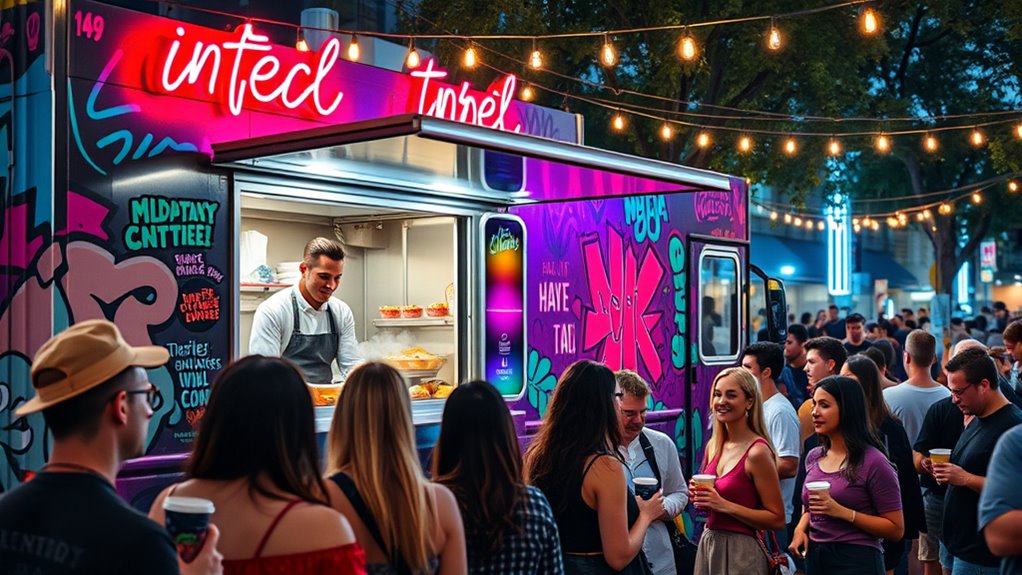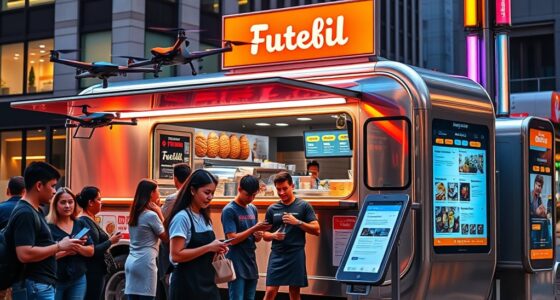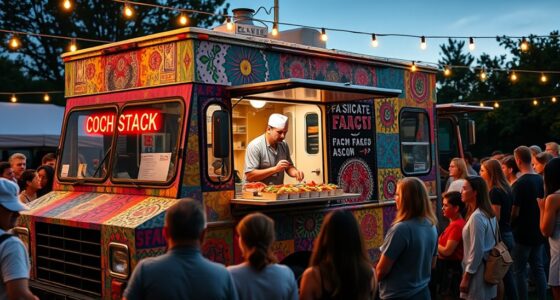You’ll notice the food truck industry is changing fast with tech advancements like AI analytics, real-time location apps, and digital payments making operations smoother. Sustainability also plays a big role, with eco-friendly practices, local sourcing, and zero waste efforts gaining popularity. Menu diversity, including global cuisines and dietary options, attracts more customers. Plus, focusing on hygiene, strategic locations, and memorable experiences helps you stand out. Keep exploring these trends to stay ahead in the game.
Key Takeaways
- Adoption of advanced digital technologies like AI analytics, IoT inventory management, and mobile apps enhances efficiency and customer experience.
- Emphasis on sustainability through eco-friendly practices, local sourcing, renewable energy, and zero waste initiatives.
- Menu diversification featuring global cuisines, fusion flavors, and dietary trend options to attract diverse customers.
- Integration of digital payment systems and strategic location planning for seamless transactions and increased foot traffic.
- Focus on branding, customer engagement, themed experiences, and collaborations to build loyalty and market presence.
Adoption of Advanced Technology Solutions

The food truck industry is increasingly embracing advanced technology solutions to stay competitive and improve efficiency. AI-driven analytics help you make smarter decisions by analyzing sales patterns, customer preferences, and operational data in real time. This enables you to optimize menus, pricing, and staffing. IoT inventory management revolutionizes stock control by providing constant updates on ingredient levels, reducing waste and preventing shortages. You can track supplies automatically, ensuring you always have what’s needed without overstocking. These technologies streamline your operations, save time, and cut costs. By leveraging AI analytics and IoT systems, you stay ahead of competitors, adapt quickly to changing demand, and deliver a better customer experience. Embracing these solutions is essential for modern food trucks aiming for growth and success. Predictive analytics can further refine your forecasting accuracy, helping you anticipate future trends and customer needs more effectively.
Emphasis on Sustainable and Eco-Friendly Practices
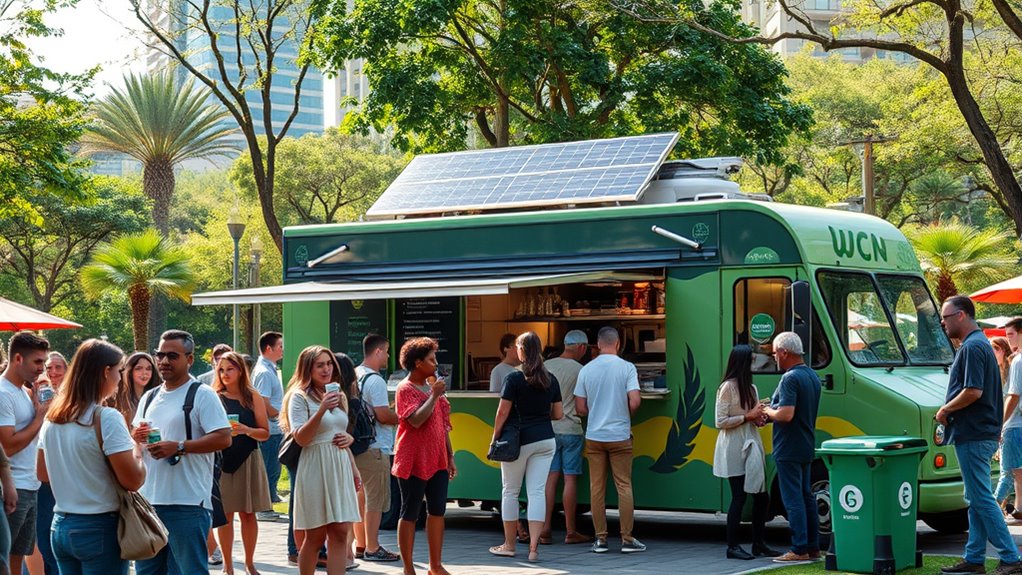
You’ll notice food trucks are increasingly adopting green energy solutions like solar panels and electric power. Many are also implementing zero waste initiatives and prioritizing local sourcing to reduce their environmental impact. These eco-friendly practices are becoming essential for staying competitive and responsible in the industry. Incorporating sustainable office practices into their operations can further enhance their environmental commitments and efficiency.
Green Energy Solutions
As the food truck industry evolves, increasing emphasis is placed on adopting green energy solutions to reduce environmental impact. You can make a difference by integrating eco-friendly practices that lower emissions and energy costs. For example: 1. Installing solar panels on your truck’s roof provides renewable energy, cutting reliance on grid power. 2. Shifting to electric vehicles reduces greenhouse gas emissions and noise pollution. 3. Using energy-efficient appliances minimizes electricity consumption during busy hours. Incorporating high-efficiency projectors into your setup can further reduce energy use and improve visual displays.
Zero Waste Initiatives
Implementing zero waste initiatives is essential for making your food truck more sustainable and eco-friendly. You can start by establishing recycling programs to sort and divert waste from landfills, ensuring materials like plastics, metals, and paper are properly processed. Composting initiatives also play a critical role in reducing organic waste; by composting food scraps and biodegradable materials, you minimize landfill contributions and create nutrient-rich soil. These practices not only reduce your environmental footprint but also appeal to eco-conscious customers. Incorporate reusable containers, utensils, and sourcing eco-friendly packaging to complement your waste reduction efforts. By actively managing waste through recycling programs and composting initiatives, you demonstrate your commitment to sustainability and set a positive example within the food truck industry. Effective waste management can help you stay compliant with local regulations and enhance your brand reputation.
Local Sourcing Emphasis
Prioritizing local sourcing not only supports nearby farmers and producers but also considerably reduces the carbon footprint associated with transportation. By focusing on seasonal ingredient sourcing, you guarantee fresher, more flavorful dishes while minimizing environmental impact. Building local farmer partnerships fosters trust and transparency, strengthening your supply chain. To deepen your commitment to sustainability, consider: 1. Using seasonal ingredients to reduce waste and energy consumption. 2. Collaborating with local farmers to ensure ethical practices and quality produce. 3. Promoting eco-friendly packaging that aligns with your local sourcing efforts. Incorporating sustainable investment strategies can further enhance your eco-conscious initiatives and attract like-minded customers. This emphasis on sustainability resonates with eco-conscious customers and demonstrates your commitment to eco-friendly practices, helping your food truck stand out in a competitive market. Embracing local sourcing not only benefits the environment but also boosts your reputation and community ties.
Diversification of Menu Offerings

You’ll notice food trucks are expanding their menus by exploring global cuisines and dietary trends. This shift helps attract diverse customers and keeps offerings fresh and exciting. Embracing these changes can give your food truck a competitive edge in a crowded market. Incorporating timeless classics alongside innovative dishes allows for a balanced and appealing menu.
Expanding Global Cuisines
As food truck operators seek to stand out in a competitive market, expanding global cuisines has become a key strategy for diversifying menu offerings. You can attract diverse customers by incorporating fusion flavors and embracing cultural fusion. This approach allows you to create unique dishes that blend culinary traditions, offering an exciting twist on familiar favorites. To deepen your menu, consider these options:
- Experiment with Asian-Latin fusion tacos for bold flavors.
- Incorporate Middle Eastern spices into classic American sandwiches.
- Offer Mediterranean-inspired bowls with a twist of local ingredients.
Incorporating Dietary Trends
Incorporating dietary trends has become essential for food trucks aiming to appeal to a broader customer base. Offering gluten free options shows your commitment to inclusivity and health-conscious diners. Many people seek gluten-free meals, so providing these options can set you apart from competitors. Additionally, using vegan friendly ingredients allows you to cater to plant-based consumers and those with dairy or egg allergies. Incorporating these dietary preferences into your menu demonstrates flexibility and responsiveness to customer needs. You might experiment with gluten-free buns or wraps, and include plant-based proteins like tofu or tempeh. Staying current with dietary trends not only broadens your audience but also enhances your reputation as a versatile, customer-focused food truck. Ultimately, diversifying your menu keeps your offerings fresh and relevant, especially when highlighting seed superfoods like chia seeds, which can add nutritional value and appeal to health-conscious customers.
Integration of Digital Payment Systems
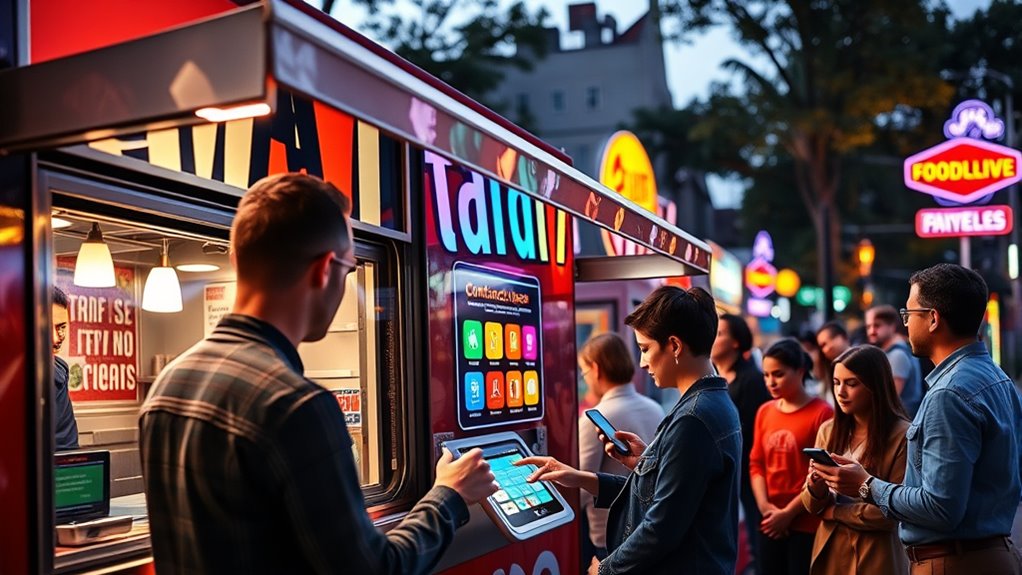
The integration of digital payment systems has become a crucial trend shaping the food truck industry, as more operators seek to streamline transactions and improve customer experience. By adopting contactless payments, you reduce wait times and enhance safety, especially in busy environments. Mobile ordering also allows your customers to place orders ahead, increasing efficiency and turnover. To make the most of this trend, consider these key points:
- Offer multiple contactless payment options like Apple Pay or Google Wallet.
- Promote mobile ordering to boost sales and reduce queue congestion.
- Ensure your POS system is compatible with various digital payment platforms for seamless transactions.
- Utilizing payment security measures can help protect customer data and build trust in your digital payment options.
Embracing these technologies helps you stay competitive, attract more customers, and deliver a modern, convenient experience.
Strategic Location Planning and Mobile Accessibility
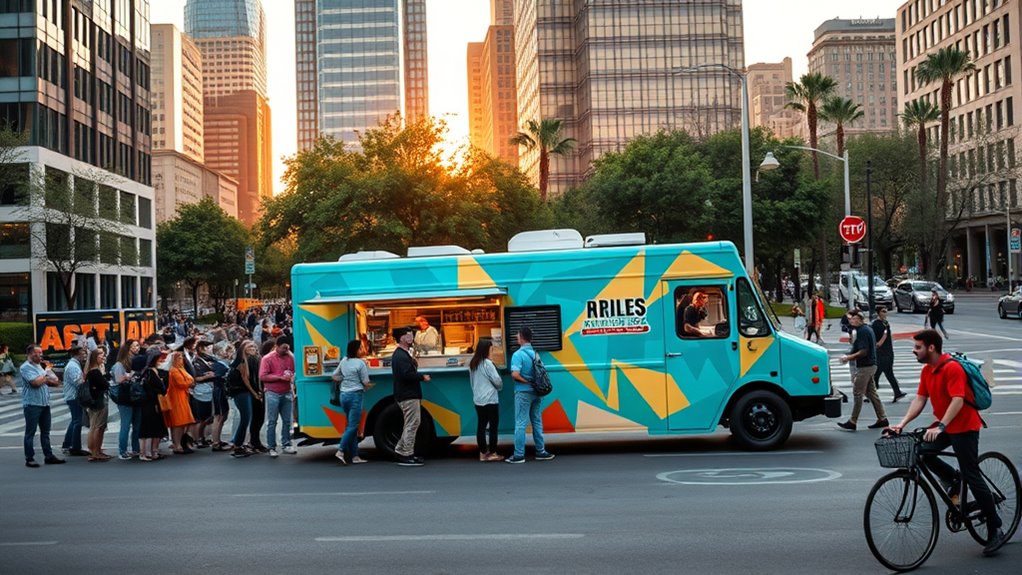
Choosing strategic locations and guaranteeing mobile accessibility can considerably boost your food truck’s success. Securing the right parking permits allows you to operate in high-traffic areas where customers gather, increasing sales. Planning your locations based on foot traffic, events, and local regulations ensures you’re always in the right spot. Additionally, leveraging mobile app navigation helps customers find you easily, especially when you move between locations. This technology allows you to update your whereabouts in real-time, attracting more patrons and reducing idle time. Incorporating automation technologies can further streamline your operations and improve efficiency. By combining well-chosen spots with seamless mobile accessibility, you create a consistent customer experience that encourages repeat visits. Focus on these elements to maximize your visibility, streamline operations, and grow your food truck business effectively.
Embracing Food Safety and Hygiene Standards
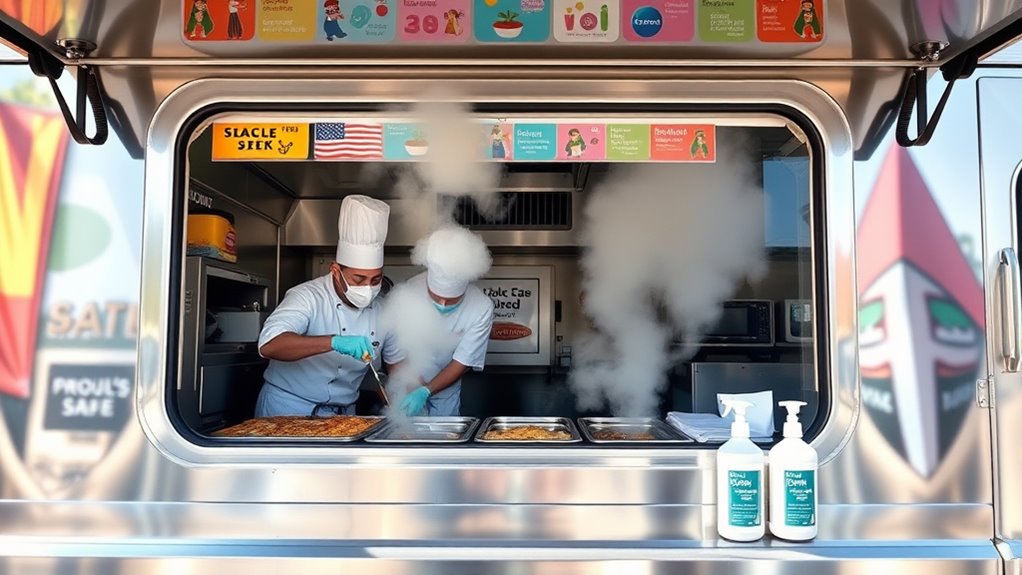
Maintaining high food safety and hygiene standards is essential for building customer trust and ensuring your food truck operates legally and ethically. When you prioritize cleanliness and safety, you reduce the risk of contamination and avoid costly penalties. Regular food safety audits help identify areas for improvement, while obtaining hygiene certifications demonstrates your commitment to quality. To stay compliant and competitive, consider these key actions: 1. Conduct routine food safety audits to monitor standards. 2. Ensure staff are trained and certified in hygiene protocols. 3. Maintain strict cleanliness of all equipment and surfaces. Additionally, staying informed about food safety standards can help you implement best practices and maintain a reputable operation.
Collaboration and Branding Opportunities
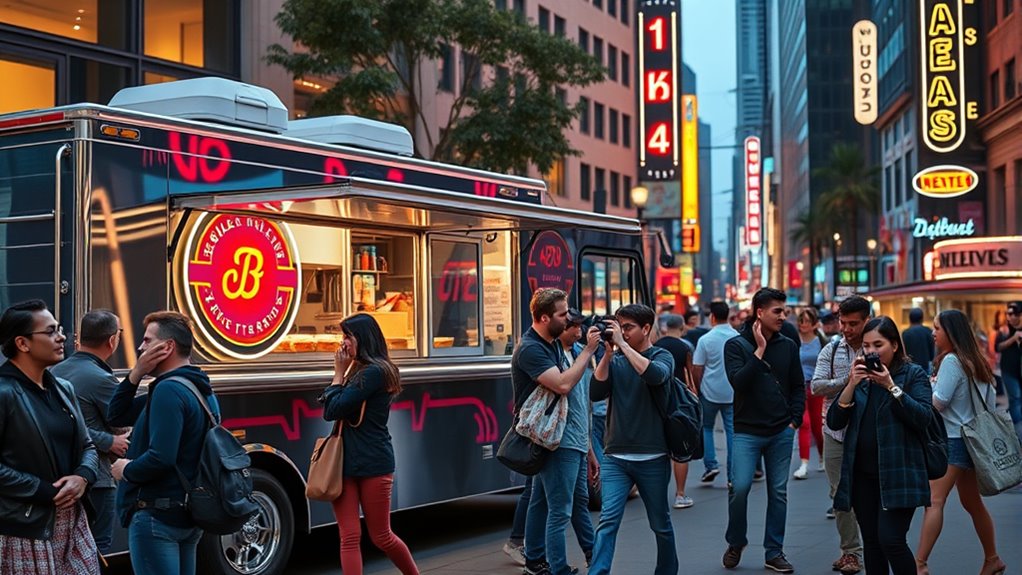
Have you considered how strategic collaborations and strong branding can boost your food truck’s visibility and customer loyalty? Partnering with local brands or events through brand partnerships can expand your reach and create buzz. Co-marketing campaigns allow you to share resources, reduce costs, and attract diverse audiences. Building a recognizable brand helps you stand out in a crowded market, making customers more likely to return. Think about aligning with complementary vendors or community initiatives to amplify your presence. The table below highlights key aspects of collaboration strategies:
| Strategy | Benefits |
|---|---|
| Brand Partnerships | Increased exposure |
| Co-Marketing Campaigns | Shared audiences, cost savings |
| Local Collaborations | Community trust, loyalty |
| Event Sponsorships | Brand visibility |
| Cross-Promotions | Customer engagement |
Understanding the importance of personality traits can also help tailor marketing efforts and customer engagement strategies to better connect with your audience.
Focus on Unique Customer Experiences
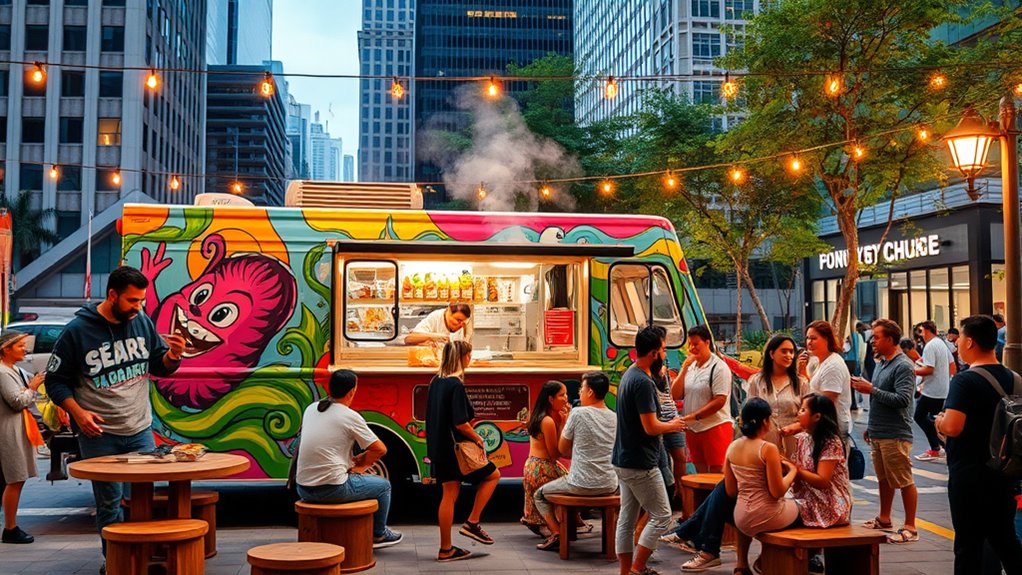
Building on your branding efforts, creating memorable customer experiences can set your food truck apart in a competitive market. Focus on personalized service that makes each customer feel valued and understood. You can also craft immersive environments by incorporating themed decor or interactive elements that engage your audience. To deepen your impact, consider these strategies:
- Offer customized menu options tailored to customer preferences.
- Design your truck’s interior with eye-catching visuals or thematic setups.
- Host events or live entertainment to foster a lively, memorable atmosphere.
- Incorporate customer engagement techniques to encourage repeat visits and positive word-of-mouth.
Frequently Asked Questions
How Do Food Trucks Adapt to Changing Health Regulations?
You adapt to changing health regulations by staying informed and updating your procedures promptly. To guarantee health compliance, you might revise your menu to include healthier options and follow new safety standards. Menu innovation helps meet customer demand for nutritious choices, while strict adherence to health codes keeps your truck operational. Regular staff training and clear documentation also support compliance, making your food truck a trusted and compliant business.
What Role Does Social Media Play in Food Truck Marketing?
Social media strategies are essential for your food truck marketing, helping you reach a broader audience quickly. You can showcase your menu, share location updates, and engage with customers directly. Influencer collaborations boost your visibility, attracting new fans and building trust. By consistently posting appealing photos and responding to comments, you create a vibrant online presence that drives foot traffic and encourages repeat visits, making social media a powerful tool for your success.
How Are Food Trucks Influencing Local Restaurant Trends?
Like a modern-day culinary muse, food trucks influence local restaurant trends by introducing gourmet fusion dishes that excite diners. You see, their emphasis on eco-friendly packaging inspires nearby eateries to adopt sustainable practices. This ripple effect pushes traditional restaurants to innovate, blending street food creativity with upscale dining. As a result, both sectors thrive, shaping a vibrant culinary scene where convenience and sustainability go hand in hand, transforming your local food landscape.
What Challenges Do Food Trucks Face in Urban Environments?
In urban environments, you face challenges like parking restrictions that limit where you can operate, making it tough to find suitable spots. Noise complaints from nearby residents or businesses can also hinder your daily operations. These issues require you to plan your locations carefully and maintain good community relations. Traveling through city regulations and managing public perception are key to keeping your food truck business thriving amidst city life challenges.
How Is Customer Feedback Integrated Into Food Truck Operations?
You integrate customer feedback into your food truck operations by actively collecting data through customer surveys and establishing feedback loops. Listening to your customers helps you identify what they love and what needs improvement. You then adjust your menu, service, or ambiance based on their input, creating a cycle of continuous improvement. This approach guarantees your food truck stays responsive, customer-focused, and competitive in a dynamic market.
Conclusion
As you navigate these industry trends, it’s clear that embracing innovation and sustainability gently guides you toward greater success. Staying adaptable and attentive to evolving customer preferences helps you stand out without feeling overwhelmed. By thoughtfully integrating new technologies, eco-friendly practices, and memorable experiences, you create a welcoming environment that subtly encourages loyalty. Remember, in this dynamic landscape, a gentle shift towards progress can open doors to exciting opportunities without losing sight of what matters most.
